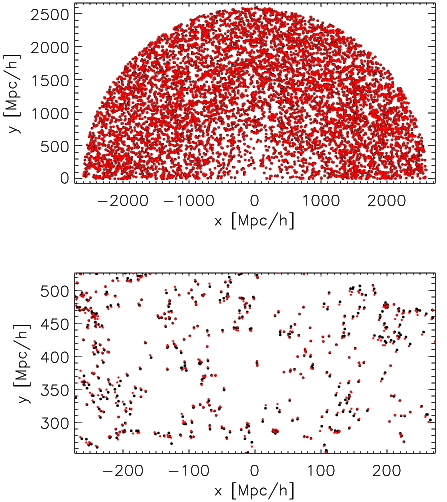The Kavli Institute for Cosmological Physics (KICP) at the University of Chicago will host Non-Gaussianity Hub workshop on April 19-21, 2012. We plan to bring together theorists and data analysts in this 3-day workshop on non-Gaussianity to consolidate the recent progress and discuss future efforts. We expect attendance by about 30 worldwide leaders in the field of non-Gaussianity.
Simulations to Disscuss
Come to the workshop with your constraint on f_NL not worrying about systematics or uncertainties in the other cosmological parameters and work on the analysis of simulations:
- How would the systematics enter?
- What about inflationary input?
- Model -> observables?
Simulation 1
Acknowledgments: Thanks to Michael Busha, Matt Becker, Brandon Erickson, Andrey Kravtsov, Gus Evrard, Risa Wechsler and others who made this possible.
The simulation results are posted here.
The file contains nearly 2 million halos out to z~1.1. The columns are M200c x y z redshift ra dec where M200 is mass (with that definition), x, y, z are are comoving positions in the light cone in Mpc/h, and redshift, ra and dec are self-explanatory. Each halo has at least 100 particles (note, a fixed cut at 100 particles is at different effective thresholds on the mass function as the halo population evolves in z). Matt Becker computed the redshift with the peculiar velocity and ra, dec for each halo (using the correct cosmology).
"Ascii and FITS format files are posted, along with a simple validation plot to confirm that the halos in redshift space look OK. The black points are in redshift space and the red points are not. The observer is at (0,0) and this is a simple slice in dec, looking at all ra and comoving distance computed either using just the Hubble redshift or the total redshift with peculiar velocity. "
- Matt Becker
The file contains nearly 2 million halos out to z~1.1. The columns are M200c x y z redshift ra dec where M200 is mass (with that definition), x, y, z are are comoving positions in the light cone in Mpc/h, and redshift, ra and dec are self-explanatory. Each halo has at least 100 particles (note, a fixed cut at 100 particles is at different effective thresholds on the mass function as the halo population evolves in z). Matt Becker computed the redshift with the peculiar velocity and ra, dec for each halo (using the correct cosmology).
"Ascii and FITS format files are posted, along with a simple validation plot to confirm that the halos in redshift space look OK. The black points are in redshift space and the red points are not. The observer is at (0,0) and this is a simple slice in dec, looking at all ra and comoving distance computed either using just the Hubble redshift or the total redshift with peculiar velocity. "
- Matt Becker
Simulation 2
Acknowledgments: Thanks to Martin Crocce, Francisco Castander, Pablo Fosalba, Enrique Gaztanaga, and the MICE team.
The simulation results and README file are posted here.
The simulations are Gaussian. Our mocks covers 5000 sq deg down to z ~ 1.4. it's build with halos in the light-cone of a very large simulation with box-size 3Gpc/h aside. The mass resolution is similar to Matt Becker's mocks but the cut its on ~ 1012 (so we have halos starting with 10 particles per halo). Total number of objects is 47 million. We provide radial positions of objects in real, redshift and (gaussian) *photo-z* space.
The simulations are Gaussian. Our mocks covers 5000 sq deg down to z ~ 1.4. it's build with halos in the light-cone of a very large simulation with box-size 3Gpc/h aside. The mass resolution is similar to Matt Becker's mocks but the cut its on ~ 1012 (so we have halos starting with 10 particles per halo). Total number of objects is 47 million. We provide radial positions of objects in real, redshift and (gaussian) *photo-z* space.
Organizing Committee
| Peter Adshead Kavli Institute for Cosmological Physics |
Scott Dodelson KICP/Fermilab |
Dragan Huterer University of Michigan |
Workshop Dinner
The workshop dinner will be held on Thursday, April 19, 2012 at the Cedars Mediterranean Kitchen. The transportation to the hotel after the dinner will be provided.



